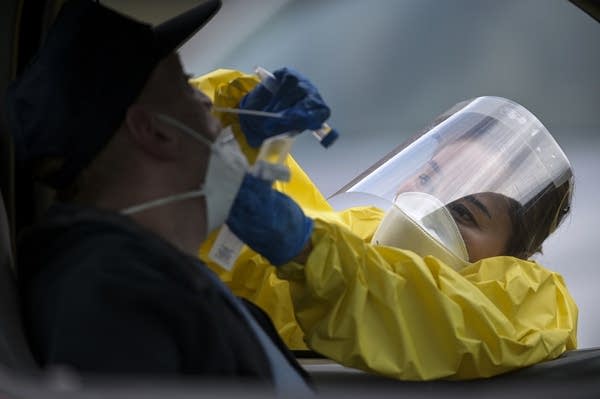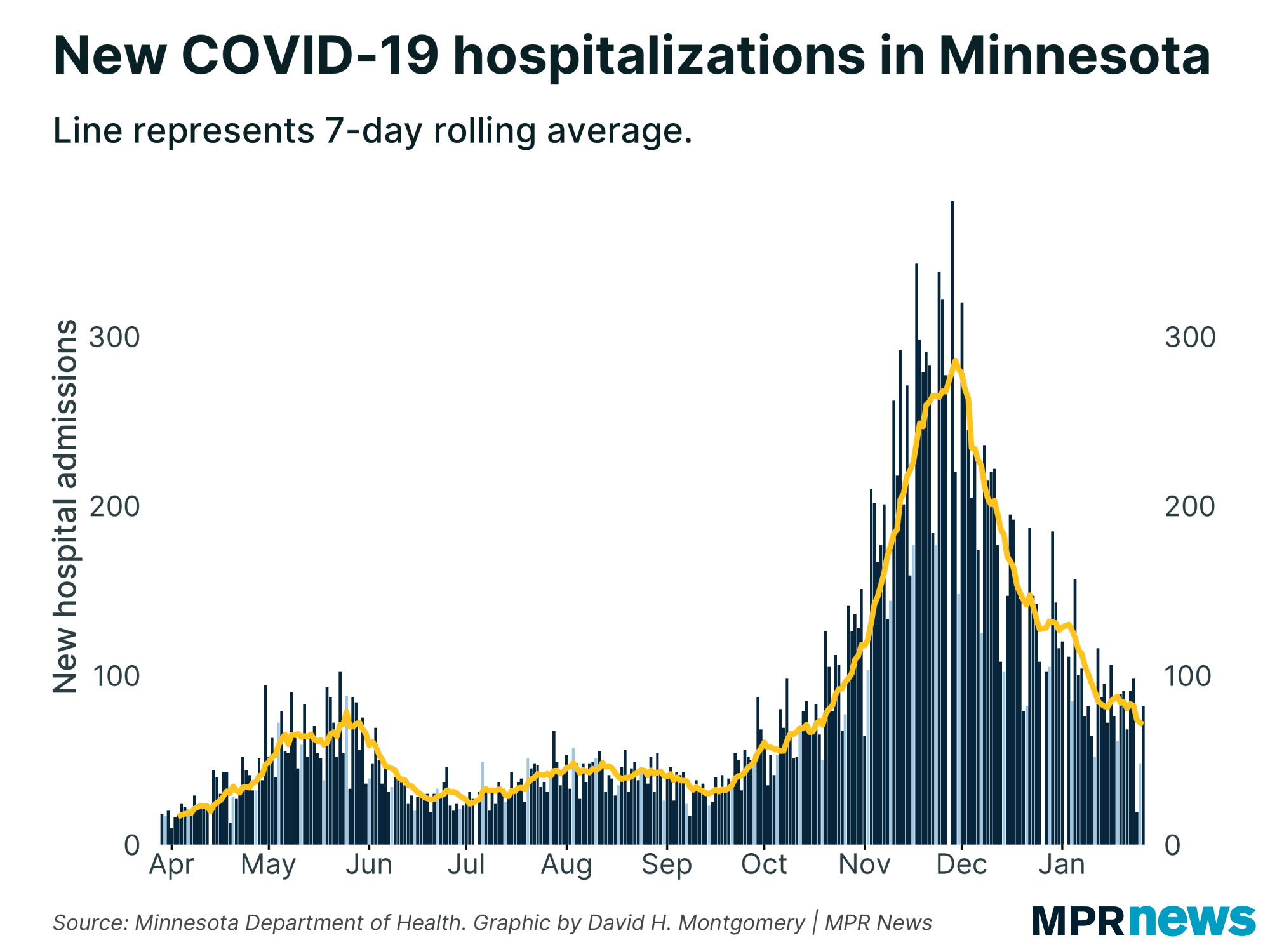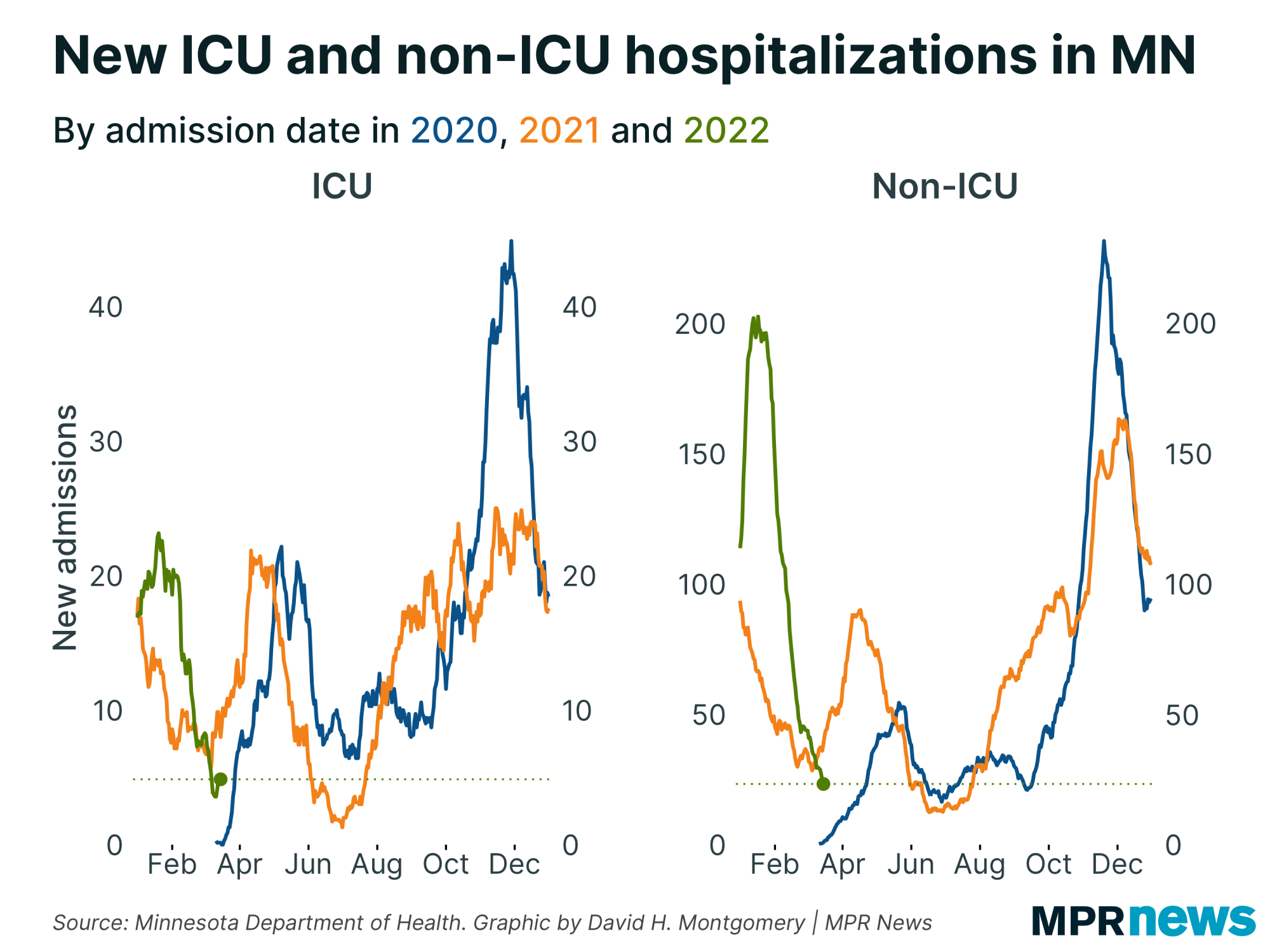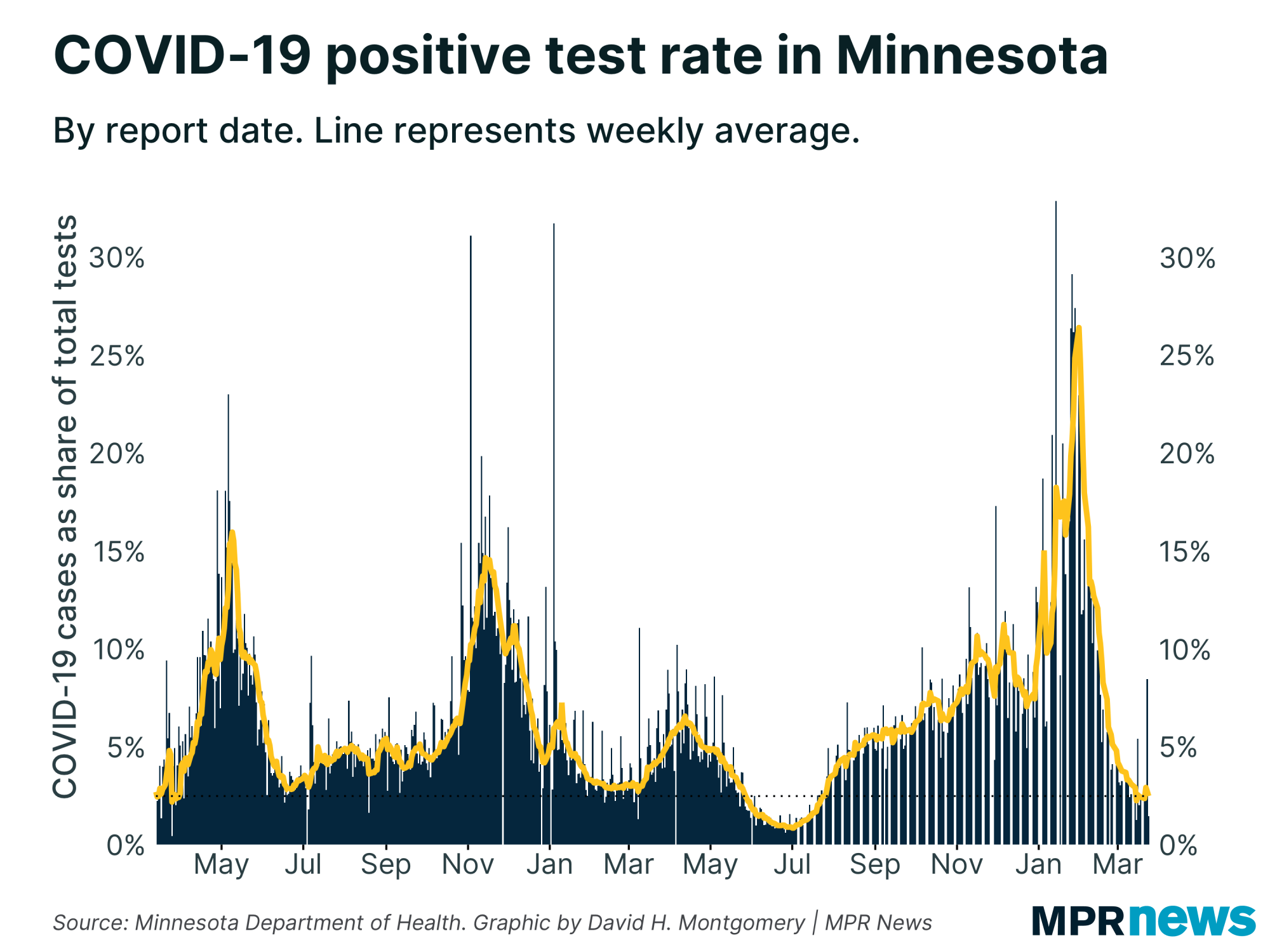Nov. 14 update on COVID-19 in MN: Record 8,703 new cases; 35 more deaths

Go Deeper.
Create an account or log in to save stories.
Like this?
Thanks for liking this story! We have added it to a list of your favorite stories.
Updated: 12:45 p.m.
Minnesota health officials reported a record daily increase of 8,703 new COVID-19 cases on Saturday, along with 35 more deaths in what’s been the state’s deadliest week of the pandemic.
The rolling seven-day averages for new COVID cases, hospital admissions and deaths in Minnesota are at all-time highs.
And that spiking case count is a signal that hospitalizations and deaths will continue to climb in the coming weeks, as those numbers lag behind positive tests.
Michael Osterholm, director of the Center for Infectious Disease Research and Policy at the University of Minnesota, told reporters on Friday that the lag time means continued stress for doctors, nurses and other medical staff.
Turn Up Your Support
MPR News helps you turn down the noise and build shared understanding. Turn up your support for this public resource and keep trusted journalism accessible to all.
"I worry very much about the fact that health care workers — we've asked them to run three marathons today, and then we ask them to run three marathons tomorrow and the next day. At some point they can't continue to run those marathons. They are just simply mentally and physically exhausted," he said.
Saturday’s record number of cases came on a record high testing volume of nearly 52,000 tests. But case counts have been trending upward faster than increases in testing.
The average positivity rate for tests over the past week is now 15 percent. State officials have long considered 5 percent a concerning number.
The deaths reported Saturday included 27 residents of long-term care facilities.
Grim numbers have been all too common this week in Minnesota’s struggle with COVID-19. The seven-day average death toll in Minnesota is now above 35 deaths a day, about twice as high as two weeks ago. The average number of COVID-19 hospital admissions each day is about 217.
“For Minnesota, it’s a very challenging time right now,” Gov. Tim Walz told reporters Friday, noting that one of the recent deaths was a 21-year-old with no underlying health conditions.
Here are Minnesota’s current COVID-19 statistics:
2,874 deaths (35 new)
216,028 positive cases (8,703 new); 167,234 off isolation
More than 3.3 million tests; more than 2.1 million people tested
15 percent seven-day positive test rate (officials find 5 percent concerning)

Walz on Friday again implored people to wear masks in public gathering spaces, socially distance and stay home if you don’t feel well. “It is time to suck it up and get through this.”
Asked later about clamping down with fines on people and businesses to get them to comply, a clearly frustrated Walz replied: “I just need folks to do this. I need folks to follow along and get us through this.”
Minnesotans, he said, can “control our destiny in this. We can choose to make those choices around masking. We can choose to believe this is real and quit playing that this is somehow not ... is like the flu or something. None of those things were true at the beginning. None of those things are true now.”
Walz suggested that more restrictions on daily life may be needed as the pandemic continues to rage in Minnesota, with the worst still to come.
While a complete lockdown of the state’s economic and social life was unlikely, the governor indicated more moves may be coming beyond his latest order closing bars and restaurants to indoor service after 10 p.m., which kicks in Friday night.
“I think more changes will probably have to happen,” he told reporters hours after the latest Minnesota Health Department data showed the virus spreading uncontrollably across the state with deaths and hospitalizations climbing significantly.
More new, awful records
The Health Department on Saturday reported nearly 46,000 known, active cases. The number was below 19,000 two weeks ago.

As of Friday more than 1,400 people were in Minnesota hospitals now because of COVID-19, with nearly 300 needing intensive care, according to Health Department data.
The numbers follow a drumbeat this week of troubling new daily highs in cases, hospitalizations and deaths.
A bright sign in the data was the record number of COVID-19 tests. Experts say expanded testing could help control the outbreak by helping to identify cases early before people can spread the disease.

The U of M’s Osterholm urged Minnesotans to do their part to stem the spread of the disease for a few more months until a vaccine becomes available.
“If we can just hold out until then, it can save so many lives … save so much suffering,” he told reporters Friday.
Caseloads rising across age groups
New cases have been spiking the past two weeks in all age groups.
People in their 20s still make up the age bracket with the state’s largest number of confirmed cases — more than 44,000 since the pandemic began, including more than 24,000 among people ages 20-24.

The number of high school-age children confirmed with the disease has also grown, with more than 17,000 total cases among children ages 15 to 19 since the pandemic began.
The numbers help explain why experts remain particularly concerned about teens and young adults as spreaders of the virus.

Although less likely to feel the worst effects of the disease and end up hospitalized, experts worry youth and young adults will spread it to grandparents and other vulnerable populations.
It’s especially concerning because people can have the coronavirus and spread COVID-19 when they don’t have symptoms.
Walz on Tuesday said the state has data showing infection rates rising around bar and restaurant activity after 9 p.m. among young adults, noting that people who have the virus but don’t have symptoms are unwittingly spreading it.
Virus surges in swaths of rural Minnesota
Regionally, central and northern Minnesota have driven much of the recent increase in new cases while Hennepin and Ramsey counties show some of the slowest case growth in the state.
Northwestern Minnesota no longer has the state’s fastest-growing outbreak. It’s been passed by east-central Minnesota. But new cases are rising at accelerating rates nearly everywhere.

Collectively, rural areas of Minnesota continue to report the most new COVID-19 cases.
Northern Minnesota, once the region least affected by the disease, has also seen its caseload grow dramatically in recent weeks.

In Itasca County in northeastern Minnesota, COVID-19 cases are surging to the point that county health officials have suspended individual contact tracing, citing a record high rate of infections through community transmission.
“If you are in a group setting, just assume that someone has COVID,” Kelly Chandler, department manager for Itasca County Public Health, said in a statement earlier in the week.
Latino cases jump
In Minnesota and across the country, COVID-19 has hit communities of color disproportionately hard in both cases and deaths. That’s especially true for Minnesotans of Hispanic descent.

Distrust of the government, together with deeply rooted health and economic disparities, have hampered efforts to boost testing among communities of color, officials say, especially among unauthorized immigrants who fear their personal information may be used to deport them.
Similar trends hold true for Minnesota’s Indigenous residents. Counts among Indigenous people jumped in October relative to population.
Cases among all races and ethnicities continue to rise, although currently the growth is slowest among Black Minnesotans, who reported the most new COVID-19 cases per capita for much of the spring and summer.
‘Change our behaviors’
Minnesota public health leaders for weeks have warned the state’s skyrocketing COVID-19 caseload would bring more hospitalizations and deaths. Those warnings are coming to pass in a succession of new highs in cases, hospitalizations and deaths.
On Thursday, Gov. Tim Walz told the state’s executive council that Minnesota is on pace to reach 300,000 cases by Thanksgiving.

The disease’s rampant spread is being fueled by informal gatherings and get-togethers with family and friends, transmitted unknowingly by people who have the virus but do not have symptoms, officials say.
State officials say that’s been especially true among people ages 18 to 35, which are more likely to unwittingly transmit the virus.
‘So much community spread’
The overall numbers continue to paint a troubling picture of a rapidly worsening pandemic in Minnesota not limited to just one region or demographic group, like earlier in the pandemic.
There’s increasing concern about the ability of hospitals to handle more. They were already filling in the summer and fall from normal use, and the surge in COVID-19 patients is putting hospitals in the Twin Cities “near the top of their capacity,” Health Commissioner Jan Malcolm said last week.

Staffing is becoming a challenge as more health care workers get sick, she reiterated on Friday.
“There is so much community spread … hundreds of thousands of decisions that area being made every day” are fueling the rate of infections.
Walz noted that while Minnesota had prepared well to add hospital capacity to meet the expected surge in cases, the rising illness among care workers was a key problem now.
“It’s not good enough just to have the bed space,” he said. “You need the workforce.”
Developments around the state
COVID-19 outbreak reported in Minnesota Senate GOP caucus
The Minnesota Senate Republican caucus is dealing with a COVID-19 outbreak.
At least two Minnesota senators, Rochester’s Dave Senjem and Plymouth’s Paul Anderson, have confirmed they have tested positive for COVID-19.
An internal email obtained by MPR News says there have been a number of cases identified among the GOP lawmakers and their staff. A caucus spokeswoman wouldn’t quantify the number of people who are ill, citing medical privacy.
Anderson says his positive test result was just received but he had been in self-quarantine all week after experiencing symptoms.
He was not among the small number of senators at the Capitol for this week’s special session. Most participated remotely. Lawmakers aren’t expected to hold another session until mid-December.
Senate DFL leader Susan Kent said her caucus was not informed about the positive COVID-19 tests prior to Thursday's special session. She issued a statement Friday night calling that "outrageous and completely unacceptable."
"This lack of transparency is a blatant disregard for the health and safety of others: our DFL and non-partisan staff, members, and the communities we go home to,” Kent said.
A Senate GOP spokeswoman said no one from the Republican caucus who was in attendance at Thursday's special session posed a risk of spreading COVID-19.
DFL Gov. Tim Walz issued a statement Saturday saying that anyone who knows about a positive COVID-19 test has a "moral obligation" to inform others who may be at risk.
“As elected officials, we must lead by example. I simply do not understand why Senate Republicans chose only to share that there were positive cases in their caucus with members of their own party before Thursday’s floor session," Walz said. "Injecting partisanship into public health, their actions knowingly put the safety of their DFL colleagues, non-partisan staff, and Capitol law enforcement at risk. We must put aside our differences and look out for our neighbors. At the end of the day, we are all Minnesotans.”
— Brian Bakst | MPR News
Accused mosque bomber trial on hold after juror’s spouse tested positive for COVID
The federal trial of alleged mosque bomber Michael Hari is on hold after a juror's spouse tested positive for COVID-19.
Hari, an antigovernment militia leader from Illinois, is facing hate crime and explosives charges in the 2017 attack on the Dar Al Farooq Islamic Center.
U.S. District Judge Donovan Frank called an immediate halt to the proceedings after a juror got word of his spouse's positive COVID test during the Friday lunch break. Frank said the the trial could resume on Thursday at the earliest if the juror receives two negative test results. But even then, he'll likely be excused as a precaution to the others. There are two alternates.
The court has taken extensive health precautions. All observers must watch via closed circuit TV. People in the courtroom are spread out, and there are plexiglass barriers.
Before the judge sent the jurors home, they'd heard testimony from 25-year-old Joe Morris, who pleaded guilty to his role in the attack. Morris admitted breaking a window at the mosque before 31-year-old Michael McWhorter threw a pipe bomb inside.
By testifying, the two are hoping to avoid 35-year mandatory minimum sentences.
— Matt Sepic | MPR News
Health Department to start tracing efforts with texts
Beginning Monday, people who have tested positive for COVID-19 or who have been in contact with a positive case will be notified by text before receiving a phone call from a contract tracer.
The hope is increase the rate of answered or returned phone calls to contact tracers. The text will include the contact tracer’s number.
“The idea is to more effectively reach and inform those who test positive for COVID-19 and their close contacts about what they need to do to prevent further spread and to better protect the state’s most vulnerable populations through improved outreach and communication,” Health Commissioner Jan Malcolm said Friday.
— MPR News Staff
Latest COVID data suggest shift to distance learning for most Minn. counties
Newly released data from the Minnesota Health Department shows that over 60 Minnesota counties should shift their students to distance learning.
Once county case rates reach 50 or more per 10,000 residents, Minnesota schools are meant to switch all their elementary, middle and high school students to distance learning.
According to the latest release of data, more than two thirds of Minnesota counties have now reached that threshold. But data from the Education Department shows that only 22 percent of the state’s school districts and charters are in distance learning scenarios. That is likely to change over coming days and weeks.
Still, the Health Department's recommendation isn't an ultimatum. Officials say county case rates of COVID-19 are meant to be just the starting point used by districts and charters in making their decision on whether to allow students to attend classes in person.
— Elizabeth Shockman | MPR News
Minnesotans can now get saliva test at MSP, at home
Minnesota is expanding its COVID-19 saliva testing capabilities across the state through a free at-home mail service. The state also opened a saliva testing location at the Minneapolis-St. Paul International Airport on Thursday.
Testing is free to Minnesota residents. Although reservations are encouraged, walk-in appointments are also available. Turnaround for mail-in testing is expected to be about 48 hours plus delivery time.
"All the results come on email, if a person doesn't have an email, some people don't have access to that technology, those patients will receive a phone call with their results within a 24- to 48-hour period,” said Shawn Baxley who works for Vault Medical Services that is partnering with the state for the new tests.
Assistant Health Commissioner Dan Huff said wearing masks, social distancing and getting tested are all ways to help stop the spread of the coronavirus in Minnesota.
The airport site is the ninth saliva-testing facility open around the state. Another saliva-testing site is opening next week in Burnsville.
— Jon Collins | MPR News
N.D. governor OKs infected nurses to keep working
The North Dakota Nurses Association says it doesn’t support a move to allow health care workers who have tested positive for COVID-19 but don’t have symptoms to remain on the job.
Gov. Doug Burgum supports the idea to ease stress both on hospitals and medical personnel amid skyrocketing coronavirus cases in North Dakota. Burgum says hospital administrators asked for the action and interim State Health Officer Dirk Wilke amended an order to allow it to take effect.
The nurses’ association says guidance from the CDC says the decision should be left to the COVID-19 positive nurse whether to work. The association says other measures, such as mask-wearing, should be used to reduce the demand on the health care system before implementing this strategy.
Burgum, a Republican, has not supported a statewide mask mandate. Instead, he’s stressed personal responsibility.
North Dakota has the highest number of new cases per capita in the nation, according to Johns Hopkins data, with one in every 83 residents testing positive in the past week.
— The Associated Press
State prison in St. Cloud locked down to combat COVID
The Minnesota state prison in St. Cloud is under modified lockdown due to a recent spike in COVID-19 cases among inmates and staff.
Recently the facility has reported 381 total positive or presumed positive cases in St. Cloud since the pandemic began, up from 179 in late October. One hundred sixty-nine of those cases have recovered.
St. Cloud serves as the intake facility for the state prison system. In July, the Minnesota Department of Corrections temporarily moved intake operations to Lino Lakes due to a COVID-19 outbreak in St. Cloud.
Corrections Commissioner Paul Schnell said they are considering whether to do that again.
"We are looking at what the alternatives are. The challenge really, at this time, we're trying to do everything we can to reduce intakes altogether,” Schnell said. “We've asked the county jails, if they would hold people for two weeks, to allow us to try and settle this."
However, Schnell says many county jails are dealing with their own spikes of coronavirus cases.
Schnell said facilities across the Midwest are seeing similar spikes, as community spread of the virus increases.
"Whether it's a correctional facility, nursing home, you can't have a massive growth in the community and not expect that to ultimately influence these congregate settings."
Schnell said the department is taking steps to contain the spread of the virus, including minimizing inmates' movement with a modified lockdown, testing of staff and inmates, and quarantining newly arriving inmates for two weeks.
— Kirsti Marohn | MPR News
Top headlines
Overwhelmed by cases, health departments struggle to trace virus' spread: Since the COVID-19 pandemic began, testing and tracing have been two key parts of the state's strategy for slowing the spread of the virus. Now, more people are getting tested than ever before. But as COVID-19 cases surge, the contact tracing side of that equation is getting overwhelmed.
COVID-19 crashes Minnesota wedding plans: As COVID-19 cases in Minnesota have climbed, Gov. Walz has put into place new restrictions on large gatherings, including weddings. For Minnesotans who’ve been planning weddings, or who work in the industry, it’s one more change in an already tumultuous year.
A guide to navigating Thanksgiving and COVID-19: At a time when everyday decisions can be fraught with risk and worry, planning for the holidays is no exception. Health officials offer some suggestions for how to frame your next family gathering.
As COVID-19 takes dire turn, Minn. lawmakers avoid clash: The Legislature convened and adjourned a special session without taking a vote to reel back Gov. Tim Walz’s executive powers. It followed news of another record day of COVID-19 infections.
COVID-19 in Minnesota
Data in these graphs are based on the Minnesota Department of Health's cumulative totals released at 11 a.m. daily. You can find more detailed statistics on COVID-19 at the Health Department website.


